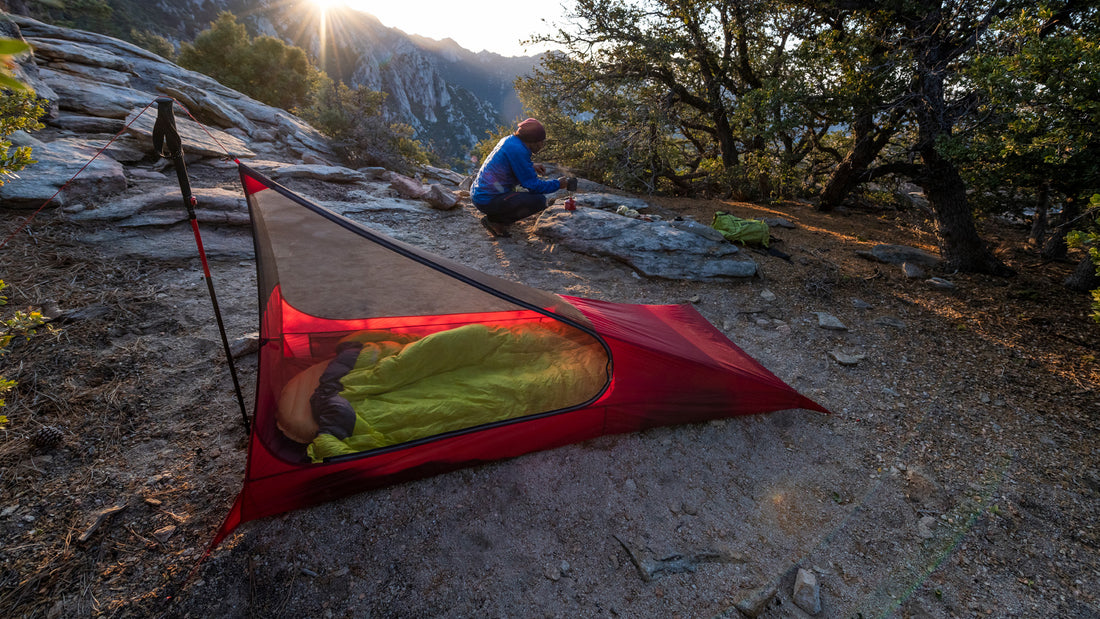
Go the Distance: The MSR Thru-Hiker Shelter System
MSR Team“We listened closely to Erin and Mike, and we feel we’ve developed the perfect shelter for thru-hikers and long-distance backpackers,” said Terry Breaux, MSR Shelter Product Manager.
The PCT Hikers
Erin is a plucky, smiley brunette who enjoys a cold beer and hot food after putting in long miles on the trail. Mike is also a smiley brunette, but with more hair on his bearded face than his crown. In 2014 they completed a 3½-month PCT hike that started at mile 652 (Walker Pass in California) and finished at mile 2402 (Snoqualmie Pass in Washington). The culmination of two years of planning while dating long-distance between Seattle and Pullman, Washington, their trip gave them an extended period of togetherness, with Erin keeping a record of their adventures on her PCT blog.
Shelter Challenges
Because there were no specific thru-hiking shelters on the market when they started their trip, Erin and Mike used a handmade tarp and bug shelter that Erin sewed herself. Their DIY shelter system offered good ventilation to help control moisture and minimize condensation, but it was on the heavy side—a clear disadvantage when covering hundreds of miles. Thru-hikers typically want a shelter that’s lightweight enough to carry and still meet mileage goals without skimping on protection (which could put one’s health at risk and end one’s trip early).
The MSR Thru-Hiker shelter system offers users like Erin and Mike the excellent ventilation and bug-free protection they want, but in an ultralight shelter with enough livable space for two or three people (depending on the model) to be comfortable for months on the trail. What’s truly unique about the design is its highly adaptable pairing system, allowing one to choose a preferred weight and protection level for a particular trip or specific thru-hike segment.
A Flexible System
One can use the Mesh House 3 (.46 kg/1 lb) on its own for maximum ventilation and bug protection. It’s the ideal ultralight shelter for mosquito-heavy environments like the marshy Sierras or the Pacific Northwest woods, where the bugs became so bad for Erin and Mike on their trip that the latter wrote an ode to mosquitos.
In rougher weather, one can pair the Thru-Hiker Mesh House with the Thru-Hiker 70 or 100 Wing (sold separately) for added wind and rain coverage.
A smaller or bigger Wing can be matched with a smaller or bigger Mesh House to meet specific weight and protection preferences. This adaptable system is also flexible in terms of setup: adjustable cords on each corner or point let one set up the Wing at different heights—lower in bad weather; higher for more ventilation. Some thru-hikers may choose to use a Mesh House and Wing together, or to split them up for use on different trip sections. A PCT thru-hiker with news of trail and weather conditions up ahead can ship the Mesh House or Wing to a drop site further along the route, keeping what’s essential for the current conditions while preparing for future shelter needs.Of course, one doesn’t have to hike the PCT to appreciate the Thru-Hiker system’s flexibility. Ultralight backpackers or tarp users on multi-day excursions can save further weight by using trekking poles, trees, or even paddles to set up the shelter system. This setup video shows all the pairing and setup options.
Lessons Learned
With feedback from Erin and Mike’s PCT experiences, MSR engineers were able to fine-tune the Thru-Hiker shelter system. Lots of micromesh proved to be a critical factor in maintaining airflow in higher, cooler elevations, where trapped moisture from their breath would have otherwise caused their shelter to become cold and clammy.
The couple also reported that in areas prone to wetter weather, they had wished for additional shelter space to dry gear. To add this functionality, the MSR team reinforced the top of the Mesh House, so users could spread out damp clothes and utilize the airflow between Mesh House and Wing to help speed the drying process.




